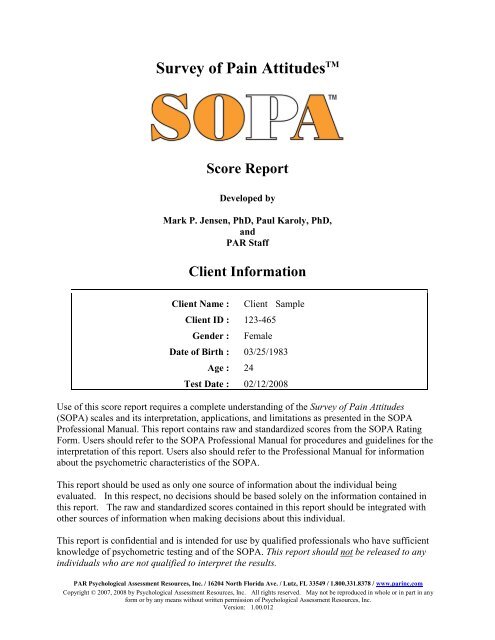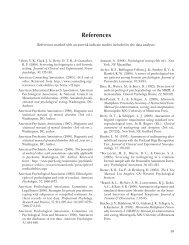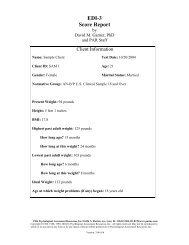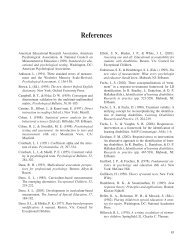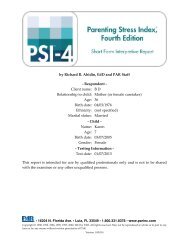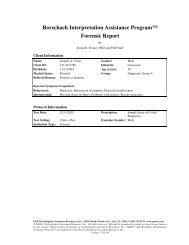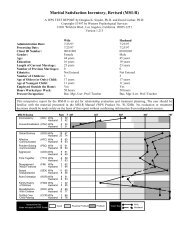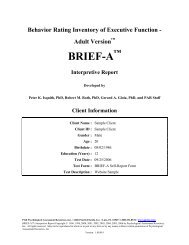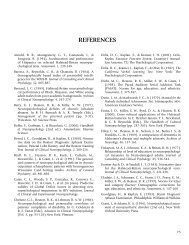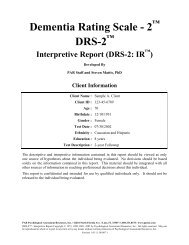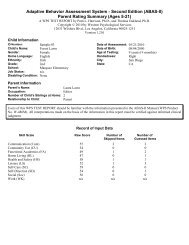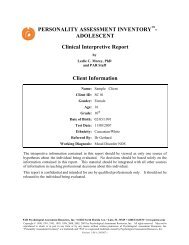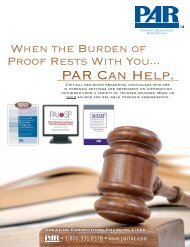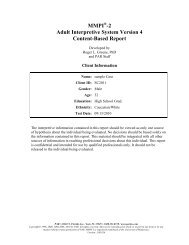SOPA Score Report - Psychological Assessment Resources, Inc.
SOPA Score Report - Psychological Assessment Resources, Inc.
SOPA Score Report - Psychological Assessment Resources, Inc.
- No tags were found...
You also want an ePaper? Increase the reach of your titles
YUMPU automatically turns print PDFs into web optimized ePapers that Google loves.
Survey of Pain Attitudes TM<strong>Score</strong> <strong>Report</strong>Developed byMark P. Jensen, PhD, Paul Karoly, PhD,andPAR StaffClient InformationClient Name :Client SampleClient ID : 123-465Gender :FemaleDate of Birth : 03/25/1983Age : 24Test Date : 02/12/2008Use of this score report requires a complete understanding of the Survey of Pain Attitudes(<strong>SOPA</strong>) scales and its interpretation, applications, and limitations as presented in the <strong>SOPA</strong>Professional Manual. This report contains raw and standardized scores from the <strong>SOPA</strong> RatingForm. Users should refer to the <strong>SOPA</strong> Professional Manual for procedures and guidelines for theinterpretation of this report. Users also should refer to the Professional Manual for informationabout the psychometric characteristics of the <strong>SOPA</strong>.This report should be used as only one source of information about the individual beingevaluated. In this respect, no decisions should be based solely on the information contained inthis report. The raw and standardized scores contained in this report should be integrated withother sources of information when making decisions about this individual.This report is confidential and is intended for use by qualified professionals who have sufficientknowledge of psychometric testing and of the <strong>SOPA</strong>. This report should not be released to anyindividuals who are not qualified to interpret the results.PAR <strong>Psychological</strong> <strong>Assessment</strong> <strong>Resources</strong>, <strong>Inc</strong>. / 16204 North Florida Ave. / Lutz, FL 33549 / 1.800.331.8378 / www.parinc.comCopyright © 2007, 2008 by <strong>Psychological</strong> <strong>Assessment</strong> <strong>Resources</strong>, <strong>Inc</strong>. All rights reserved. May not be reproduced in whole or in part in anyform or by any means without written permission of <strong>Psychological</strong> <strong>Assessment</strong> <strong>Resources</strong>, <strong>Inc</strong>.Version: 1.00.012
Client: Client . Sample Test Date: 02/12/2008Client ID: 123-465 Page 2 of 6Survey of Pain AttitudesThe <strong>SOPA</strong> scales are divided into two general categories: (1) scales that measure AdaptiveBeliefs – beliefs that are thought to contribute to less pain and disability over time, and (2) scalesthat measure Maladaptive Beliefs – beliefs that are thought to contribute to greater pain anddisability over time. In general, research findings support these categorizations, although somescales tend to be more strongly associated with patient functioning than others (in particular,disability and harm-related beliefs have been shown to be associated with greater disability, andcontrol beliefs have been shown to be associated with less disability). However, it is important toremember that what is adaptive or maladaptive for one person may not be adaptive ormaladaptive for another.There are two Adaptive <strong>SOPA</strong> scales: Control and Emotion.The Control scale assesses the extent to which a patient believes that he or she cancontrol pain when it occurs.The Emotion scale assesses the extent to which a patient believes that his or her emotionshave an impact on the experience of pain.There are five Maladaptive <strong>SOPA</strong> scales: Disability, Harm, Medication, Solicitude, and MedicalCure.The Disability scale assesses the extent to which a patient believes he or she is disabledby pain.The Harm scale assesses the extent to which a patient believes that pain will lead tophysical damage and that he or she should avoid exercise.The Medication scale assesses the extent to which a patient believes that medication is anappropriate treatment for his or her chronic pain.The Solicitude scale assesses the extent to which a patient believes that others, especiallyfamily members, should be solicitous in response to his or her experience of pain.The Medical Cure scale assesses the extent to which a patient believes in a medical curefor his or her pain problem, and also that it is the responsibility of the doctor to reduce orcure the pain problem.
Client: Client . Sample Test Date: 02/12/2008Client ID: 123-465 Page 3 of 6<strong>Inc</strong>onsistency <strong>Score</strong><strong>Inc</strong>onsistency scoreProtocol Classification8 AcceptableThe <strong>Inc</strong>onsistency score was found to be within the acceptable range.<strong>SOPA</strong> <strong>Score</strong> Summary TableNote: The T scores and percentiles that are presented in the following table are based on a groupof patients with chronic pain assessed prior to multidisciplinary treatment.ScaleAdaptive BeliefsRawscoreT<strong>Score</strong>%ileControl 9 39 14Emotion 11 46 34Maladaptive BeliefsDisability 33 62 88Harm 21 62 88Medication 24 70 98Solicitude 22 78 >99Medical Cure 29 71 98
Client: Client . Sample Test Date: 02/12/2008Client ID: 123-465 Page 4 of 6<strong>SOPA</strong> ProfileT scoreAdaptive BeliefsMaladaptive BeliefsPercentiles 8038-4027-3231-3223-2433-36>99>997570656055504540353025 203736353433323130292827262524232221201918171615141312111098765432102625242322212019181716151413121110987654321040393837363534333231302928272625242322212019181716151413121110987654320-13029282726252423222120191817161514131211109876543210242322212019181716151413121110987654321022212019181716151413121110987654321032313029282726252423222120191817161514131211109876543210>99>99>99999999999898979696959392908886848279767369666258545046423834312724211816141210875443221111
Client: Client . Sample Test Date: 02/12/2008Client ID: 123-465 Page 6 of 6Based on the findings of Ms. Sample’s Adaptive Beliefs scales that were found in the SubclinicalRange, she might benefit from skill training and encouragement to increase the beliefs that she hascontrol over pain and its effects and that emotions can affect pain.Based on the findings of Ms. Sample’s Maladaptive Beliefs scales that were found in theSubclinical Range, she might benefit from skill training and encouragement to decrease the beliefsthat one is necessarily disabled by pain and that pain is a signal of damage.Adaptive RangeNone of the <strong>SOPA</strong> scales were found to be within the Adaptive Range.End of <strong>Report</strong>


